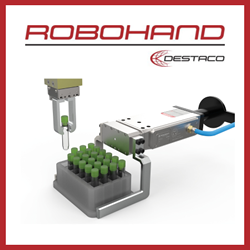There are numerous approaches to robot guidance using machine vision techniques, such as stereo vision and photogrammetry, time of flight, structured light, light coding, and laser triangulation.
 Choosing the Best Machine Vision Technique for Robot Guidance
Choosing the Best Machine Vision Technique for Robot Guidance

Matt Edwards | Kingstar
The use of machine vision for robot guidance offers new industrial operations possibilities, but also creates complex safety design challenges. This is because it is applied to machinery that operates with high repeatability and low latency, especially in complex industrial sectors. Machine vision systems must deal with critical industrial issues like lighting conditions, texture-less surfaces, and undetermined and moving objects. Therefore, effective robot guidance requires specific machine vision sensors and techniques.
There are numerous approaches to robot guidance using machine vision techniques, such as stereo vision and photogrammetry, time of flight, structured light, light coding, and laser triangulation. The technique ideal for a specific application depends on its requirements. To determine the ideal machine vision technique to apply, consider the application’s goal and its type of robot, as well as factors including:
- The range of the sensor: The working distance is determined by environment configuration, accessibility of the robot, and size of the sensor.
- The accuracy of resolution and point cloud alignment: Resolution and point cloud alignment are determined by the hardware. They should be consistent with the application purpose and size of the object.
- Light weight: If a sensor is mounted in the end effector or on-board, a robot operates on limited max load weight to achieve its full dynamics.
- Processing time: Processing duration is important in determining whether a system is ideal for a specified application, especially when it is applied to robots with safety constraints like the ability to sense and prevent collisions with obstacles and humans. Some machine vision techniques operate with static cameras and objects so they cannot be applied in moving processes.
- Safety issues: Although robots can operate independently, they require human intervention and also work closely with industry employees. Therefore, sensors should prevent dangerous high-powered lasers to reduce the risk of accidents in automated industries.
- Scanning environment: The slightest environmental fault in vibrations, lighting conditions or camera movements can affect the quality of 3D point cloud greatly. Hence, such interferences should be avoided by scanning the environment prior to engagement.
- Hardware and software integration: Cameras are automatically controlled by an external source as well as their robot central control unit. As such, impromptu developments are oriented towards hardware and software integration. Most commercial machine vision systems are connected to a robot that is in turn controlled by external software.
- Budget: Apart from technical issues, an industry’s budget should be considered when choosing the ideal machine vision technique to implement. The right solution should balance cost and performance.
These factors are a starting point for selecting the ideal technique for an industrial application. However, further research can provide more information about techniques like structured light, laser triangulation, and stereo vision, which can offer acceptable accuracy when implemented under particular conditions.
The content & opinions in this article are the author’s and do not necessarily represent the views of RoboticsTomorrow
Comments (0)
This post does not have any comments. Be the first to leave a comment below.
Featured Product

